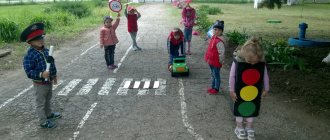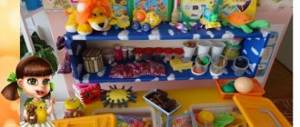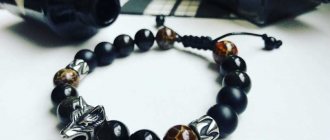Advantages of the material
Manufacturers point out that kinetic sand has a number of advantages over natural substances. The advantages include the following:
This product is very plastic and safe for children. It has a pleasant texture and provides scope for the development of the child’s creative imagination.- It is very easy to make figures from it, since, unlike ordinary sand, it retains its shape well.
- Does not require special storage conditions. The shelf life indicated on the packaging - 3 years - can easily be extended.
- In this case, the mass does not dry out.
- The polymer environment prevents the emergence and spread of pathogenic bacteria. This information can be very important for parents who are concerned about the health of their children. After all, in ordinary sandboxes, which are located on children's playgrounds, you can often see cats and dogs walking.
- It is easy to wash, and moisture ingress does not affect its performance.
- Kinetic sand is sand for children that does not crumble. It has a viscous structure. It may appear to have magnetic properties. And the smooth fluidity gives the impression that it is alive.
- Cleaning it is not particularly difficult. It can be easily removed from the table with just a damp cloth, and if particles of sand get on the carpet, they can be removed with a vacuum cleaner.
Among the minor inconveniences that you may encounter when using the material is the odor that silicone polymers have. It smells a little like glue, but dissipates quickly enough and doesn't cause much trouble.
How to make kinetic sand with your own hands
When choosing recipes for making toys at home, it is important to rely on safe components: in particular, the common method based on office glue and boric acid involves the use of gloves while playing. Against this background, food options are more rational.
Necessary materials
A list of non-aggressive components will help you obtain a non-toxic mass:
- clean sand - 4 cups. The material can be purchased at a hardware or zoological store. It needs to be scattered on a baking sheet and baked in the oven to disinfect it;
- potato or corn starch, flour - 2 cups;
- boiled cooled water;
- food colorings.
To prepare kinetic sand at home, you will need potato starch.
You can knead the mixture in a plastic bowl; you will also need a strong spatula.
Cooking kinetics
First way:
- Mix starch and quartz sand in a container.
- Add water to the mixture in small portions, stirring the mixture to achieve a semi-crumbly consistency.
Second way:
- Dissolve starch in water to form a creamy mixture.
- Add quartz sand.
- Mix the ingredients thoroughly until smooth.
To make colored play sand you will need food dyes; safe children's paints will serve as an alternative. The dye is diluted in a small amount of water and combined with the sand-starch preparation before the main volume of liquid is introduced. If the homemade mass hardens during the process, it should be slightly moistened.
Summary of GCD in the senior group “Sand, clay, earth”
Educator:
Right!
The rain is pouring - she drinks everything.
Everything else turns green and grows (earth)
Children's answers.
Educator:
Right!
Educator:
He opens the box and contains a glass of sand, clay, and earth.
Educator:
Guys, today we will explore sand, clay and earth. So, let's enter our laboratory and begin the research (the screen is pulled back, there are trays on the table with a glass of sand, a spoon, a mold for sand, a glass of water, a straw, napkins).
— At the beginning of our work, let’s remember the rules of behavior in our laboratory:
Don't try what you're experimenting with!
Do not pour sand into your eyes, do experiments carefully!
Listen carefully to the teacher!
Work together!
Wash your hands after experimenting!
— We will begin our research by studying sand. Look at it carefully.
1 experience:
"Where does sand come from"
Material:
stones, sheets of white paper, magnifying glass.
Progress of the experiment:
Take 2 stones and knock them against each other, rub them over a sheet of paper.
How do you think it's pouring in?
Take your magnifying glasses and look at this.
How did we get sand?
How does sand appear in nature?
Conclusion:
Wind and water destroy stones, resulting in sand.
— What is sand made of? (from grains of sand) What color? (light brown) Take sand with a spoon and pour into a plate. Does it flow well? What can be said about sand if it can be poured? What is he like? (Loose) Now take the tubes and gently blow on the sand, what happens?
Children's answers.
Educator:
The grains of sand move because they lie separate from each other.
What happens if you pour a little water into the sand? How do you think? (Children's answers) Where did the water go? (Children's answers).
Educator:
Can we say that the sand absorbed water and became wet? Can we say that wet sand is free-flowing? (No, loose only dry) Which sand is easier to build something from - wet or dry? (Children's answers).
Conclusion:
Guys, what have we learned about sand: sand consists of many small grains of sand, usually different. Sand (dry) is free-flowing, so the wind can easily move sand grains. If you wet it, the grains of sand stick together and stick to your hands and to each other.
- Now let’s move on to another table (the plates on the table are covered with napkins).
2 experience
: Raise the napkins! What do we see? How did you guess that it was clay? (Children's answers.)
- Look at it carefully. What color is it? (brown) Take it in your hands, remember! Is it easy to wrinkle? (children's answers)
- Let's pour some water into a bowl of clay and see what happens. Where did the water go? (It doesn't pass through clay well) How has the clay changed? (It has become plastic, soft, you can sculpt from it.) Guys, I also want to tell you that in Dagestan there is a village called Balkhar, where craftsmen make clay jugs and toys. (Showing jugs)
Is colored sand safe?
On sale you can often find kinetic sand of various colors and shades. Many parents are concerned about what is included in its composition and how safe it is. Manufacturers claim that such products contain only natural ingredients and there is no reason for parents to worry. The advantages of such a product include the following:
- It is very bright, so it is more attractive to children.
- Provides greater opportunities for creativity and creativity. A child can mix different colors, experiment and get new shades.
The only downside is that as children begin to mix one color with another, very soon all the sand can turn into a simple gray mass. To somehow solve this problem, you can do the following.
Buy sand of different colors, but do not give it all to your child at once. For example, give out certain colors every day in small quantities.
Sand activities for preschoolers
Good afternoon, dear parents and loved ones of preschool children! Many kids love to dig around in the sandbox, so tired adults can rest a little on a bench. But sand activities for preschoolers are not only an interesting and relaxing pastime, but also a great way to relax and unleash your creative potential.
While playing in the sandbox, the baby will be able to:
- develop imagination and fine motor skills;
- become more diligent and collected;
- build and change shapes and lines, modeling and resolving life situations;
- strengthen the muscles of the palms and hands, which is important for writing;
- calm down and relieve stress.
Properties and types of sand
- Natural sand . It can be wet or dry. Both types are great for activities with children, they just need to be used for different purposes. If you want your baby to work with it at home, then sift it through a sieve and bake it in the oven for disinfection purposes.
- Kinetic sand . In addition to natural sand in the sandbox or on the beach, you can purchase special kinetic sand for your child. How is it different from natural? Bright color, unusual, pleasant texture, binding properties. The fact is that it contains a viscous substance that holds small particles together. Thanks to it, the material feels like wet sand, but it does not stick to your hands at all, and the figures made from it perfectly retain their shape. With a slight impact on the figurine, it again turns into a pile of modeling material.
DIY kinetic sand
Do you want your child to have a lot of bright material for modeling? You'll have to fork out the money or make it yourself. Believe me, it's not difficult at all. We will need:
- sifted sand - 4 cups;
- starch - 2 cups;
- water - 1 glass;
- food coloring - 1 sachet.
Mix starch and water in a deep container. Add dye to the mixture. Add sand and mix ingredients. Kinetic sand is ready.
Sandbox at home
To practice with sand in the cold season, you can make a sandbox for your home with your own hands or buy a ready-made version. There are bright plastic sandboxes with a lid on sale that can be placed both indoors and outdoors. There are also options that, after purchase, need to be assembled from individual parts. The easiest way is to take a wide plastic bowl and simply fill it 2/3 with bulk material.
"Sand" pastime
Most children don't need to be told what to do with this great material - just provide it - but we'll still give you some fun ideas.
Acquaintance
How to introduce a child to sand and the rules for handling it? After all, it can give not only pleasant sensations, don’t you agree? Tell a 2-3 year old child how painful it can be if it gets in the eyes. And it tastes very unpleasant. And also that there is no need to scatter sand around the sandbox, otherwise it will quickly end.
To develop your child’s vocabulary, offer him a couple of riddles about sand:
He emerged from stones, came into the light as grains: Yellow, red, white, or light gray. Either it is sea, or it is river. Guess who it is!
Petya builds the castle deftly, Katya bakes a cake with a bucket. Here, by the sea for an hour, I gathered all the children...
Tell your child that with his help you can come up with many games and fairy tales. Let the child stroke it with his palm. Ask him: what kind of sand? Is it cold or warm? Rough or smooth? Dry or wet? Let him squeeze it in his fist and let go, sift it between his fingers, run his fingers over it.
Moisten dry sand with water. Show your little one that you can make a figure out of it with your hands or using molds.
Find out and draw
Blindfold your baby and let him touch some familiar figure. And then ask him to draw what he imagined with his finger in the sand. At the same time, let him name the figure. This activity develops fine motor skills, imagination, and tactile sensations of the child.
Detective
Children enjoy searching for treasures. Take a handful of coins with you to the beach or bury them in the sandbox. Hand your baby a sieve, or let him look for coins by raking dry sand with his hands. Let him enjoy the process leisurely, or arrange a timed game for two or more children. Whoever found the most coins in a minute won.
Making Easter cakes
Kids love to make all kinds of cakes, pastries and Easter cakes from wet sand. To develop vocabulary, tell him the poem “Kulichiki”:
We fetch water from a puddle. We need three buckets of water. Here is a golden sand, We will pour water on it. Dirt flows down your elbows, And your whole face is covered in sand. My friend and I bake Easter cakes from sand. Tyap-blunder - everything is in order, This Easter cake is very sweet, Lush and rosy, Just like mom’s.
Drawing patterns
To prepare your hands for writing, it will be useful for your baby to draw on dry sand with his fingers, the edges of his palms, and make stamps with his fists. You can give your baby tasks for a specific finger - for example, draw a sun with your little finger or make drawings by grouping fingers of two or three.
Sand animation
To practice sand animation, use a special installation with a glass surface and illumination from below, as well as fine sand. By creating simple drawings that replace each other, you can create a real sand fairy tale! At the same time, the child feels like a real creator, and his growing self-confidence allows him to create even more complex and interesting stories. If you turn on smooth classical music, then a good mood and peace of mind are guaranteed for both you and your baby.
What's the result?
Games in the sandbox are a great opportunity to develop a child’s abilities and create a creative atmosphere. Thanks to this loose and pliable material, the baby will be able to:
- broaden your horizons;
- express your inner experiences and rethink them;
- develop in a calm, friendly environment.
Well, we wish you to captivate your baby with active, educational activities, and see you soon!
Storage and care rules
These products do not require special storage conditions. It does not dry out from exposure to air or sun. Maintains its consistency throughout the entire period of use. When applying, you should follow a few simple rules:
- If the mass has become less soft, you need to lightly moisten your hands with water and knead it. There is no need to add water to the sand itself.
- If water does get on the product, you need to wait until it dries. To do this, just keep it open for some time. No additional heat treatments are required.
- Before using the product for the first time, wash your hands thoroughly.
- After playing with the sand, you need to put it back into the container and close the lid well. This is necessary in order to protect the toy from dust, moisture and other small objects.
- No dyes should be added to the mixture, as this may spoil the properties of the product.
- If a child spills sand, it can easily be collected by hand and used further. And small particles can be removed with a vacuum cleaner and a wet cloth.
- You can store the magic mass as long as you like.
Thus, today the kinetic product is a real godsend for parents, since it has many advantages: under no circumstances does it lose its unique properties, is easy to use, unlike plasticine, does not stick and does not leave stains and marks on clothes and household items. In addition, it brings great joy to children and can help in establishing harmonious family relationships.
Originally posted 2018-05-01 06:45:33.





